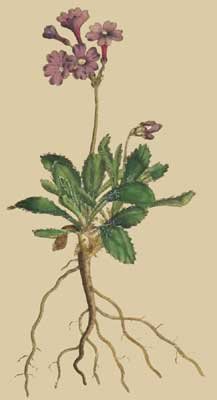Primula Marginata
Flowers

Primula Marginata
There is no difficulty in determining the British plants of this genus, but much in ascertaining many of the foreign ones Professor Jacquin has taken great pains to elucidate them in his Miscel. Austr. where fifteen are specifically described, none of which accord exactly with the plant here figured, which has every appearance of being a distinct species in the Hortus Kewensis it is described as the glutinosa of the Flora Austriaca, with which it agrees in many respects, but specimens sent from Vienna shew it to be a different plant, in its farinaceous tendency it accords with the Primula Auricula, but is very unlike that plant as it is figured in its wild state by Prof. Jacquin, in the Fl. Austr. the leaves being much narrower, the flowers larger, and of a different colour, it differs from glutinosa in the shortness of its involucrum, from villosa (already figured) in having leaves much narrower, perfectly smooth in respect to villi, and in the colour of its blossoms, which approach that of the Lilac, but more especially in its disposition to become mealy, particularly on the edges of its leaves, between the serratures, where it is so strong as to make the leaf appear with a white or silvery edge, as this character is constant to it, and not to any other species of Primula that we are acquainted with, we have given to it the name of marginata.
Mr. Lee received it from the Alps in the year 1781, and it has continued in our gardens ever since unaltered by culture. It is a very delicate pretty plant, with a pleasing musky smell, and flowers in March and April. To succeed in its cultivation, it should be placed in a pot of stiffish loam, mixed with one third rotten leaves, bog earth, or dung, and plunged in a north border, taking care that it does not suffer for want of water in dry seasons, thus treated, it increases by its roots nearly as readily as the Auricula, and may be propagated by parting its roots early in April or September.
 Catesbaea Spinosa
Catesbaea Spinosa Bellis Perennis var
Bellis Perennis var Passiflora Ciliata
Passiflora Ciliata Geranium Reichardi Dwarf Geranium
Geranium Reichardi Dwarf Geranium Blitum Virgatum
Blitum Virgatum Crepis Barbata Bearded Crepis or Purple eyed Succory Hawkweed
Crepis Barbata Bearded Crepis or Purple eyed Succory Hawkweed Coronilla Varia
Coronilla Varia Pulmonaria Virginica
Pulmonaria Virginica Colutea Arborescens
Colutea Arborescens Viburnum Tinus
Viburnum Tinus Lamium Orvala
Lamium Orvala Hypericum Balearicum
Hypericum Balearicum Test your English Language
Test your English Language  Benefits of Pears
Benefits of Pears Emperor Ashoka
Emperor Ashoka Horse Breeds
Horse Breeds Best Places to Celebrate Xmas
Best Places to Celebrate Xmas Precautions while using Internet Banking
Precautions while using Internet Banking Kabir Das
Kabir Das Ideas to increase Website Traffic
Ideas to increase Website Traffic What to Eat in Rajsthan
What to Eat in Rajsthan Healthy Mouth
Healthy Mouth Healthy Nails
Healthy Nails Healthy Neck
Healthy Neck




